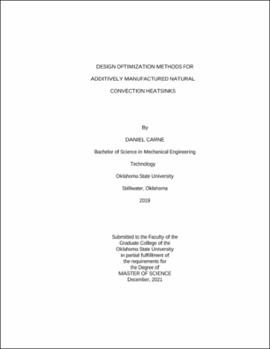| dc.contributor.advisor | Alexander, Aaron | |
| dc.contributor.author | Carne, Daniel | |
| dc.date.accessioned | 2022-05-13T19:05:29Z | |
| dc.date.available | 2022-05-13T19:05:29Z | |
| dc.date.issued | 2021-12 | |
| dc.identifier.uri | https://hdl.handle.net/11244/335801 | |
| dc.description.abstract | With 3-D printing technology becoming more widely available, designs with complex geometries are now feasible to manufacture. The ability to create complex geometries opens many new possibilities in the optimization field. Without these manufacturing constraints, unique heatsink designs can be made. Efficient methods of creating heatsinks Designed for Additive Manufacturing (DfAM) are still lacking and not readily available to industry. This research investigates two different optimization methods for heatsinks. The first method investigates applying an evolutionary algorithm to optimize vertically mounted heatsinks. A custom code was used to simulate both the conduction within the heatsink and the temperature of the fluid field around the heatsink. The optimization of the heatsink design is achieved by growing from the base and slowly adding material. In order to choose where to add material, the code trains an evolutionary algorithm based on the geometry and the temperature distribution in the metal and fluid. The second optimization method investigates the use of an Artificial Neural Network (ANN) to assist in the optimization of natural convection heatsinks. A custom Computational Fluid Dynamics (CFD) code was used to simulate the fluid and temperature fields inside and around the heatsink. The optimization of the heatsink design is achieved by choosing a sensitivity equation to decide where to add material based on factors such as velocity and convection rate. A neural network then learns the system and optimizes the variables of the sensitivity equation to increase the heat transfer of the heatsink. These optimization methods can be constrained by several options such as heat transfer characteristics, weight, and maximum envelope size. Experimental analysis is performed to show the validation of the second optimization method and benefits of DfAM. | |
| dc.format | application/pdf | |
| dc.language | en_US | |
| dc.rights | Copyright is held by the author who has granted the Oklahoma State University Library the non-exclusive right to share this material in its institutional repository. Contact Digital Library Services at lib-dls@okstate.edu or 405-744-9161 for the permission policy on the use, reproduction or distribution of this material. | |
| dc.title | Design optimization methods for additively manufactured natural convection heatsinks | |
| dc.contributor.committeeMember | San, Omer | |
| dc.contributor.committeeMember | Bradshaw, Craig | |
| osu.filename | Carne_okstate_0664M_17449.pdf | |
| osu.accesstype | Open Access | |
| dc.type.genre | Thesis | |
| dc.type.material | Text | |
| thesis.degree.discipline | Mechanical and Aerospace Engineering | |
| thesis.degree.grantor | Oklahoma State University | |
